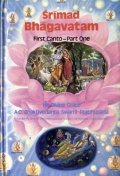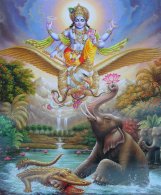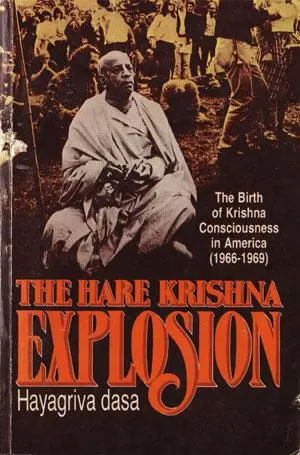…”I have no personal qualification, but I simply try to satisfy my guru, that’s all. My Guru Maharaja asked me that, ‘If you get some money, you print books.’ So there was a private meeting, talking. Some of my important Godbrothers also were there–it was in Radha-kunda. So Guru Maharaja was speaking to me that, ‘Since we have got this Baghbazar marble temple, there has been so much dissension. And everyone thinking who will occupy this room or that room. I wish therefore to sell this temple and the marble and print some books.’ Yes, so I took up this from his mouth, that he is very fond of books. And he told me personally, ‘If you get some money, print books.’ Therefore I am stressing on this point–Where is book? Where is book? So kindly help me. That is my request. Print as many books as possible in as many languages as possible, and distribute throughout the whole world. Then the Krishna consciousness movement will automatically increase.”
The next morning, while walking on Venice Beach, Srila Prabhupada delivered an extraordinary ultimatum. Surrounded by devotees, he walked along, poking the sand softly with his cane. “These seventeen volumes unpublished,” he began, “are a great problem for our movement.”
“Yes, Prabhupada,” Ramesvara responded, attentive and concerned. The other devotees also nodded, commiserating. Something must be done.
“Yes,” Prabhupada continued, “they must be published immediately.”
“Yes, Prabhupada,” Ramesvara replied obediently.
“So I think they can be printed in two months,” Srila Prabhupada said conclusively.
Ramesvara wasn’t sure he had heard correctly. The Press had only just opened. The artists didn’t even have the lights in their room. Two months was illogical, impossible. Now was the moment to tell Srila Prabhupada the plan for increased production. Ramesvara stepped closer.
“Srila Prabhupada,” he began, “we’ve been meeting about this, and now that the Press is finally here and established, I think we can increase production four times. We think that now we can go from producing one book every four months to producing one of your books every month.” Now both Ramesvara and Radhavallabha were walking together beside Srila Prabhupada, with Tamala Krishna Goswami and Brahmananda Swami walking on his other side.
“One book every month,” Srila Prabhupada said, as if thinking out loud and considering it. “That means over one year. It is not fast enough.” The other devotees looked over at Ramesvara and Radhavallabha, who glanced at each other.
“You have to do all the books in two months’ time,” Srila Prabhupada said again. They had clearly heard it this time, and the two managers were stunned in disbelief.
“Srila Prabhupada,” Ramesvara said, “I think that’s impossible. Maybe we can go faster . . .”
Srila Prabhupada suddenly stopped walking. Planting his cane firmly in the sand, he turned to Ramesvara and said, without anger but very gravely, “Impossible is a word found in the fool’s dictionary.”
Suddenly Ramesvara realized his spiritual life was on the line. To say “impossible” now would mean he had no faith in Krishna’s representative, no faith in the power of God. He must throw away his material estimations and rational common sense.
“You Have to Do All These Books in Two Months’ Time.”
Srila Prabhupada Lilamrita, April 1975
by Satsvarupa Dasa Goswami
Srila Prabhupada was thinking beyond Vrndavan. “This temple construction is so important,” he said, “that I’m willing to spend many lakhs to open a temple like this. And yet as important as it is, the book production is even more important.” This was a significant reaffirmation of the priority of book production; even while in the midst of this splendid temple opening, he was stressing that book production was more important.
Srila Prabhupada seemed displeased, however, because for months his Caitanya-caritamrita had been delayed by his Sanskrit editor. He said with a scowl that although he had finished the Caitanya-caritamrita, it remained unpublished. He had also completed all four volumes of the Fourth Canto of Srimad-Bhagavatam and was beginning the Fifth, yet only one volume of the Fourth Canto had been published.
One of the devotees present, not understanding Prabhupada’s point, remarked that since Prabhupada was going next to Hawaii he would be able to write there in peace and quiet. Prabhupada replied that he was not encouraged to write when his manuscripts were not being published.
The BBT Press, after several years in New York, was about to relocate in Los Angeles, where Ramesvara would become the new BBT Press supervisor. Ramesvara, unaware of the delay in publishing the Caitanya-caritamrita manuscript, learned of it now, in Vrindavan. He promised Prabhupada that he would immediately get the Press set up in Los Angeles and begin producing Caitanya-caritamrita.
That Srila Prabhupada had completed the entire Caitanya-caritamrita manuscript in eighteen months during 1973 and 1974 was a remarkable feat. In those same months he had been intensely engaged in many affairs of management while constantly traveling. He had confronted major problems with leaders who had left their posts, he had personally attended to GBC duties in India, and he had dealt with other ISKCON managerial affairs. He had authorized many large BBT loans and had approved the expansion and development of ISKCON in all areas of the world, in addition to responding regularly to large volumes of mail, speaking daily to guests, and giving Bhagavatam lectures wherever he went. His only time for writing had been on arising at one in the morning, and he had persistently worked two or three hours each day.
While Srila Prabhupada traveled from Vrndavan to Australia, Ramesvara and Radhavallabha worked in Los Angeles to establish the new BBT offices. Prabhupada was still meditating on his completed Caitanya-caritamrita manuscript waiting to be published. From Australia he wrote,
“The Caitanya-caritamrita is complete (12 parts) and only 3 parts are published, and now the 5th Canto is almost finished. So why these books are not being published? This is our first business. Immediately these pending books (17 in total) must all be published. Why the delay? The U.S. printer’s binding is better than Dai Nippon. So, some may be printed in the U.S. and some in Japan, but the pending books must be finished in a very short time. When I see so many books pending, it does not encourage me to translate. When I see books printed, I become encouraged to write more and more. We can talk this over more in Hawaii. Now you and Hansaduta expedite the publishing work. This is your business. And push on the selling. You request Tripurari Maharaja in this connection along with others. Now, Bhavananda Swami and Gargamuni Swami are there. They are also expert in pushing this on. By combined effort, publish as quickly as possible and immediately Caitanya-caritamrita should be done.”
In Los Angeles Ramesvara had only completed the lease arrangements for the new building for the Press. The BBT artists had just arrived, and editors, proofreaders, and other production workers would soon be coming. The Press had purchased a computer typesetter, and the devotees were being trained to use it. Carpenters knocked down walls to build a photo lab and darkroom. Additional plumbing had to be installed, and the entire Press had to be set up within one month. Srila Prabhupada was coming in June, and everything would have to be ready and running.
By the time Srila Prabhupada reached Hawaii in May, the Press in Los Angeles was preparing for operation. Srila Prabhupada’s secretary phoned Los Angeles often: “Prabhupada is angry. He keeps talking about the unpublished books. You’d better be prepared when he arrives.”
Ramesvara and Radhavallabha had investigated the necessities and the difficulties in printing the Caitanya-caritamrita manuscript, which they concluded would come to seventeen volumes. One of the main problems they discovered was the lack of an expert Bengali editor.
Most of the Caitanya-caritamrita was in Bengali. Although the BBT editors were experienced in Sanskrit, because they were not proficient in Bengali, the work was progressing slowly. Also Srila Prabhupada wanted many paintings in his books, and the art department would need many months to meet his requests.
Never before had the BBT lagged so far behind Srila Prabhupada. Ramesvara and Radhavallabha, straining their brains to produce books quickly and efficiently, devised a stepped-up production schedule. By the old schedule they could publish a book every three or four months, but on the new schedule they decided they could produce a book a month. In that way, they would eventually catch up with Srila Prabhupada. Ramesvara was eager to present Prabhupada with this plan when he came to Los Angeles.
More phone calls came from Prabhupada’s secretary. Prabhupada had heard about the preparation of the Press buildings, but he had also heard that his name had not been displayed on the front of the BBT building. He was always insistent to preserve ISKCON’s disciplic succession, foreseeing that unless ISKCON stressed A. C. Bhaktivedanta Swami as the founder-acharya, in the future persons might claim their rights of ISKCON leadership or of ownership of ISKCON properties. In the rush for completing the buildings, the BBT managers had overlooked this important detail.
June 20, 1975
On arriving in Los Angeles, Srila Prabhupada received a joyous welcome. He was accompanied by leading sannyasis and GBC secretaries, including Kirtanananda Swami, Vishnujana Swami, Brahmananda Swami, Tamala Krishna Goswami, and others. Later, sitting in his room–one of his favorites in all of ISKCON–he spoke only briefly about the backlog of unprinted books. He seemed mildly disturbed but said little. He was very pleased, however, to see the temple and the Deities of Rukmini-Dwarakadhisa.
In his short arrival speech he had explained why he was so urgently pressing his disciples to produce his books. “I have no personal qualification,” he had said from the plushly upholstered vyasasana, “but I simply try to satisfy my guru, that’s all. My Guru Maharaja asked me that, ‘If you get some money, you print books.’ So there was a private meeting, talking. Some of my important Godbrothers also were there–it was in Radha-kunda. So Guru Maharaja was speaking to me that, ‘Since we have got this Baghbazar marble temple, there has been so much dissension. And everyone thinking who will occupy this room or that room. I wish therefore to sell this temple and the marble and print some books.’ Yes, so I took up this from his mouth, that he is very fond of books. And he told me personally, ‘If you get some money, print books.’ Therefore I am stressing on this point–Where is book? Where is book? So kindly help me. That is my request. Print as many books as possible in as many languages as possible, and distribute throughout the whole world. Then the Krishna consciousness movement will automatically increase.”
The next morning, while walking on Venice Beach, Srila Prabhupada delivered an extraordinary ultimatum. Surrounded by devotees, he walked along, poking the sand softly with his cane. “These seventeen volumes unpublished,” he began, “are a great problem for our movement.”
“Yes, Prabhupada,” Ramesvara responded, attentive and concerned. The other devotees also nodded, commiserating. Something must be done.
“Yes,” Prabhupada continued, “they must be published immediately.”
“Yes, Prabhupada,” Ramesvara replied obediently.
“So I think they can be printed in two months,” Srila Prabhupada said conclusively.
Ramesvara wasn’t sure he had heard correctly. The Press had only just opened. The artists didn’t even have the lights in their room. Two months was illogical, impossible. Now was the moment to tell Srila Prabhupada the plan for increased production. Ramesvara stepped closer.
“Srila Prabhupada,” he began, “we’ve been meeting about this, and now that the Press is finally here and established, I think we can increase production four times. We think that now we can go from producing one book every four months to producing one of your books every month.” Now both Ramesvara and Radhavallabha were walking together beside Srila Prabhupada, with Tamala Krishna Goswami and Brahmananda Swami walking on his other side.
“One book every month,” Srila Prabhupada said, as if thinking out loud and considering it. “That means over one year. It is not fast enough.” The other devotees looked over at Ramesvara and Radhavallabha, who glanced at each other.
“You have to do all the books in two months’ time,” Srila Prabhupada said again. They had clearly heard it this time, and the two managers were stunned in disbelief.
“Srila Prabhupada,” Ramesvara said, “I think that’s impossible. Maybe we can go faster . . .”
Srila Prabhupada suddenly stopped walking. Planting his cane firmly in the sand, he turned to Ramesvara and said, without anger but very gravely, “Impossible is a word found in the fool’s dictionary.”
Suddenly Ramesvara realized his spiritual life was on the line. To say “impossible” now would mean he had no faith in Krishna’s representative, no faith in the power of God. He must throw away his material estimations and rational common sense.
While Ramesvara and Radhavallabha stood speechless, Srila Prabhupada resumed walking, accompanied by the others. The two devotees hurried to catch up, but now everyone looked at them as if to say, “Come on. Stop doubting. You have to do it.” Ramesvara asked Srila Prabhupada if he could discuss this with the other devotees at the Press and then report back. “Oh, yes,” Prabhupada replied, “whatever is required.” Ramesvara and Radhavallabha dropped back, while Srila Prabhupada and the others continued down the beach.
Srila Prabhupada returned to the temple and toured the new Press facilities–a graphic arts building and an editorial building. While walking outside on a second-floor veranda, he noticed below a two-foot strip of bare earth running between the two buildings. He seemed annoyed and said that they should plant grass there.
In the layout room a transparency of baby Krishna carrying Nanda Maharaja’s shoes was on the light table, and Srila Prabhupada began laughing when he saw it. He approved of the new typesetting equipment, which worked faster than the previous equipment, and when the devotees demonstrated it for him, he remarked that in India he had dreamed of having such a Press.
In Radhavallabha’s office Prabhupada sat in the production manager’s chair and looked up at the large bulletin board that displayed all the steps in the production of a book. He laughed and said, “For someone like me, this makes it even more complicated.”
Srila Prabhupada walked into every room in the two buildings and saw all the equipment. This modern technology was fine, he concluded, as long as they could use it to meet the deadline of seventeen books in two months; otherwise, their equipment was like the technology of the material scientists who tried to go to the moon–useless.
All through the morning program in the temple, Ramesvara and Radhavallabha tried to concentrate on chanting their japa and on Prabhupada’s class, but all they could think of was arranging for the production of seventeen volumes in two months. And by the time they met with the Press workers, they had become convinced it could be done. It was as if some mystical power was going to descend. Somehow or other it could be done. So they presented the plan and convinced the other workers.
“It can be done,” Ramesvara said later, talking with Srila Prabhupada. “Hmmm,” Srila Prabhupada replied.
But there were some conditions, Ramesvara said. For the Bengali editing to go smoothly, the editors would have to be able to regularly consult Srila Prabhupada. Immediately Prabhupada agreed, adding that he was prepared to stay in Los Angeles as long as necessary to insure that they met the two-month deadline. Another condition Ramesvara raised was that the artists would be working as quickly as humanly possible, but the paintings might not be of the best quality. “A blind uncle is better than no uncle,” Srila Prabhupada said. When Ramesvara mentioned that the artists would have many technical questions, Prabhupada agreed to make time to answer them. He also agreed that photographs of Indian holy places connected with Caitanya lila could be used to supplement the paintings.
After their meeting with Srila Prabhupada, Ramesvara and Radhavallabha felt that they had a chance. They left Srila Prabhupada’s room, running down the stairs. The marathon was on.
Pasted from; http://friendsofthebbt.org/node/288
Although the BBTI no longer prints the Original Sri Caitanya-caritamrta, that was printed in such a mystical way in above atricle, we do have the Original Adi-Lila Volume 1 available for sale (limited supply) by visiting http://www.theharekrishnamovement.com
















Mar 03, 2012 @ 20:04:04
thank you ,very inspiring.